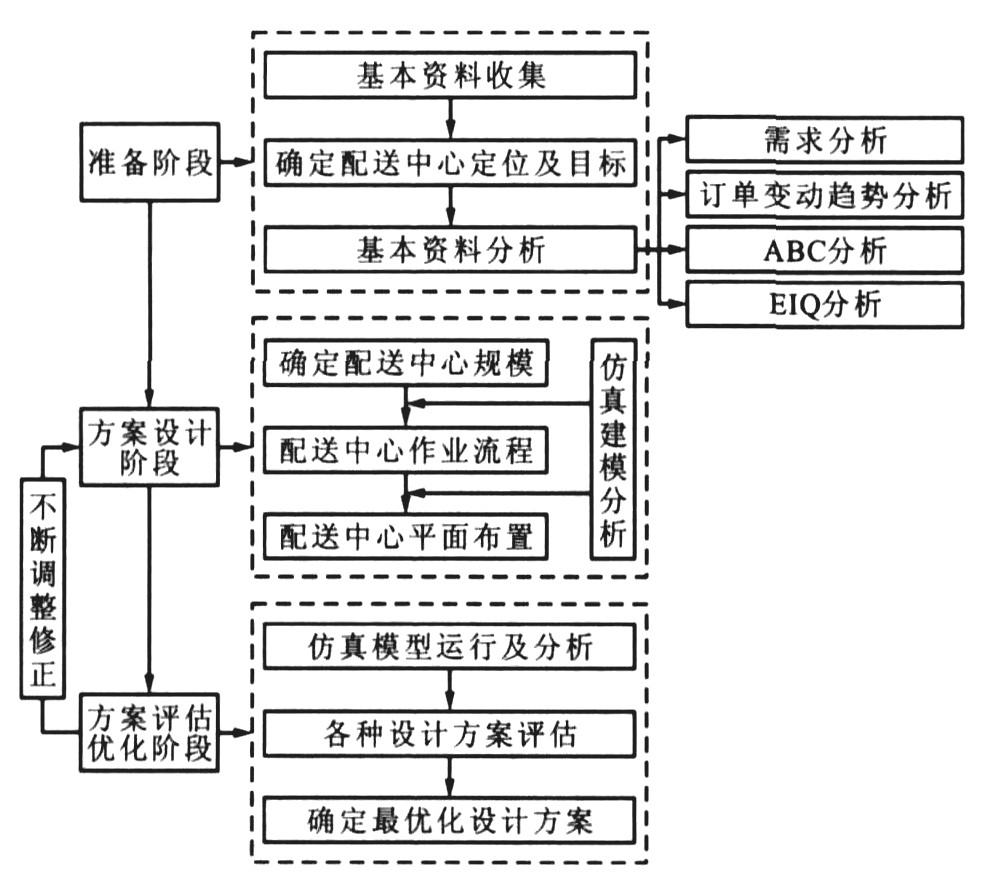Virtual layout method of distribution center of logistics based on simulation
Article Text (Baidu Translation)
-
摘要: 为了提高物流配送中心布局的客观性与运行效率, 降低物流处理成本, 分析了传统物流配送中心布局的缺点, 研究了影响物流配送中心布局的各种随机因素, 提出了物流配送中心布局的虚拟仿真设计方法。根据整理的物流配送中心布局实际参数, 确定物流中心的规模、作业流程与平面布局, 提出了配送中心布局方案, 通过计算机仿真模拟了配送中心运行过程, 计算了配送中心的空间利用率、作业能力、运行效率与运行成本, 并评价了方案的优劣。实际应用结果表明: 物流配送中心布局仿真虚拟设计方法精度高, 对规划方案的模拟、优化与选择符合客观实际。Abstract: In order to improve the layout objectivity of distribution center of logistics and running efficiency of logistics, decrease the disposal cost of logistics, the layout shortcomings of traditional distribution centers of logistics were analyzed, the effects of all kinds of stochastic factors on the layout of distribution center of logistics were studied, and a virtual simulation design method was put forward.According to the coordinated real parameters of the layout, the scale, running processes and planar layout of the center were confirmed, its design schemes were proposed, its running processes were simulated, its spatial efficiency, working capability, running efficiency and running cost were computed, and the schemes were evaluated.Applied result shows that the precision of the method is high, the optimized scheme by using the method accords with real condition.
-
Key words:
- logistics engineering /
- distribution center /
- virtual layout /
- simulation /
- modelling
-
表 1 仿真结果
Table 1. Simulation result
指标 U型 直线型 作业区能力 入出库区作业能力 订单货物入库时间/(订单数·min-1) 0.60 0.45 订单货物出库时间/(订单数·min-1) 0.58 0.51 入库暂存区利用率/% 78.0 72.0 出库暂存区利用率/% 68.0 69.5 存储作业区作业能力 电动起重机利用率/% 43 38 存储作业区面积率/% 62 60 存储作业区货物周转率/% 85 83 拣货作业区日作业能力 拣货处理能力/(箱·h-1) 450 412 日平均拣货量/箱 4820 4606 自动分拣传送带利用率/% 33.5 31.0 运行评价指标 设备时间利用率/% 25 21 配送中心日处理物流量/箱 5330 4880 费用指标 搬运费用 4520 4280 拣货费用 6750 6180 机械设备运营费用 368 426 -
[1] 陈荫三, 吴群琪. 我国发展物流业切入点的思考[J]. 交通运输工程学报, 2001, 1(3): 7-10. http://transport.chd.edu.cn/article/id/200103002Chen Yin-san, Wu Qun-qi. The basis point for developing logistics in China[J]. Journal of Traffic and Transportation Engineering, 2001, 1(3): 7-10. (in Chinese) http://transport.chd.edu.cn/article/id/200103002 [2] 程日盛. 公路运输业向现代物流业发展的对策[J]. 交通运输工程学报, 2004, 4(4): 93-96. http://transport.chd.edu.cn/article/id/200404023Cheng Ri-sheng. Developing strategies from highway freight station to modern logistic industry[J]. Journal of Traffic and Transportation Engineering, 2004, 4(4): 93-96. (in Chinese) http://transport.chd.edu.cn/article/id/200404023 [3] 赵闯, 刘凯, 李电生. SOFM神经网络在物流中心城市分类评价中的应用[J]. 中国公路学报, 2004, 17(4): 119-122. https://www.cnki.com.cn/Article/CJFDTOTAL-ZGGL200404026.htmZhao Chuang, Liu Kai, Li Dian-sheng. Application of SOFM neural network for classification and evaluation of logistics center city[J]. China Journal of Highway and Transport, 2004, 17(4): 119-122. (in Chinese) https://www.cnki.com.cn/Article/CJFDTOTAL-ZGGL200404026.htm [4] 宣登殿, 胡大伟, 蔺宏良. 基于GIS的城市物流配送系统规划方法[J]. 长安大学学报: 自然科学版, 2006, 26(2): 84-87. https://www.cnki.com.cn/Article/CJFDTOTAL-XAGL200602020.htmXuan Deng-dian, Hu Da-wei, Lin Hong-liang. Planning method of city logistics delivery system based on GIS[J]. Journal of Chang an University: Natural Science Edition, 2006, 26(2): 84-87. (in Chinese) https://www.cnki.com.cn/Article/CJFDTOTAL-XAGL200602020.htm [5] 毛海军, 张永, 李旭宏. 物流企业分类模型[J]. 交通运输工程学报, 2005, 5(2): 117-121. http://transport.chd.edu.cn/article/id/200502028Mao Hai-jun, Zhang Yong, Li Xu-hong. Logistics enterprise classifying model[J]. Journal of Traffic and Transportation Engineering, 2005, 5(2): 117-121. (in Chinese) http://transport.chd.edu.cn/article/id/200502028 [6] 袁庆达, 杜文, 黎青松. 区域公共物流中心规模和选址问题[J]. 交通运输工程学报, 2001, 1(4): 97-100. http://transport.chd.edu.cn/article/id/200104022Yuan Qing-da, Du Wen, Li Qing-song. The size andlocation of region public logistics center[J]. Journal of Traffic and Transportation Engineering, 2001, 1(4): 97-100. (in Chinese) http://transport.chd.edu.cn/article/id/200104022 [7] 李旭宏, 胡文友, 毛海军. 区域物流中心规划方法[J]. 交通运输工程学报, 2002, 2(1): 85-87. http://transport.chd.edu.cn/article/id/200201018Li Xu-hong, Hu Wen-you, Mao Hai-jun. Regional logistics center planning method[J]. Journal of Traffic and Transportation Engineering, 2002, 2(1): 85-87. (in Chinese) http://transport.chd.edu.cn/article/id/200201018 [8] 孙会君, 高自友. 一类有竞争的物流配送中心选址模型[J]. 交通运输工程学报, 2002, 2(4): 54-57. http://transport.chd.edu.cn/article/id/200204012Sun Hui-jun, Gao Zi-you. Competitive location model of lo-gistics distribution center[J]. Journal of Traffic and Transportation Engineering, 2002, 2(4): 54-57. (in Chinese) http://transport.chd.edu.cn/article/id/200204012 [9] 王家善. 设施规划与设计[J]. 工业工程, 1998, 1(1): 11-14. https://www.cnki.com.cn/Article/CJFDTOTAL-GDJX801.003.htmWang Jia-shan. Facilities planning and design[J]. Industrial Engineering Journal, 1998, 1(1): 11-14. (in Chinese) https://www.cnki.com.cn/Article/CJFDTOTAL-GDJX801.003.htm [10] 齐二石, 田青, 宋宁华. 物流系统规划设计方法综述[J]. 天津大学学报: 社会科学版, 2003, 5(3): 225-228. https://www.cnki.com.cn/Article/CJFDTOTAL-TDXS200303008.htmQi Er-shi, Tian Qing, Song Ning-hua. Reviewof methods of the planning for the logistic chain network[J]. Journal of Tianjin University: Social Sciences, 2003, 5(3): 225-228. (in Chinese) https://www.cnki.com.cn/Article/CJFDTOTAL-TDXS200303008.htm [11] Liggett R S. Automated facilities layout: past, present and future[J]. Automationin Construction, 2000, 9(2): 197-215. [12] 刘正刚, 姚冠新. 设施布置设计的回顾、现状与展望[J]. 江苏理工大学学报: 社会科学版, 2001, 3(1): 74-78. https://www.cnki.com.cn/Article/CJFDTOTAL-JSLD200101018.htmLiu Zheng-gang, Yao Guan-xin. Facility layout design: the past, the present and the future[J]. Journal of Jiangsu University of Science and Technology: Social Sciences, 2001, 3(1): 74-78. (in Chinese) https://www.cnki.com.cn/Article/CJFDTOTAL-JSLD200101018.htm [13] 赵景华, 王二乐. 计算机辅助设施布置系统[J]. 北京科技大学学报, 1995, 17(2): 143-147. https://www.cnki.com.cn/Article/CJFDTOTAL-BJKD502.009.htmZhao Jing-hua, Wang Er-le. Systemof computer aided facilities layout planning[J]. Journal of University of Science and Technology Beijing, 1995, 17(2): 143-147. (in Chinese) https://www.cnki.com.cn/Article/CJFDTOTAL-BJKD502.009.htm [14] 焦建新, 齐二石, 王小红, 等. 一种基于AHP的多目标设施布置算法及其应用[J]. 天津大学学报: 自然科学与工程技术版, 1997, 30(1): 61-66. https://www.cnki.com.cn/Article/CJFDTOTAL-TJDX701.009.htmJiao Jian-xin, Qi Er-shi, Wang Xiao-hong, et al. An AHP based multi-criteria algorithmfor facility layout andits application[J]. Journal of Tianjin University: Science and Technology, 1997, 30(1): 61-66. (in Chinese) https://www.cnki.com.cn/Article/CJFDTOTAL-TJDX701.009.htm [15] Lin L C, Sharp G P. Quantitative and qualitative indices for the plant layout evaluation problem[J]. European Journal of Operational Research, 1999, 116(1): 100-117. [16] 东南大学交通学院. 河南省传统仓储企业物流化改造关键技术及其应用研究[R]. 南京: 东南大学, 2006. [17] 项陆舟. 配送中心虚拟设计与仿真[D]. 南京: 东南大学, 2007. -





 下载:
下载:









